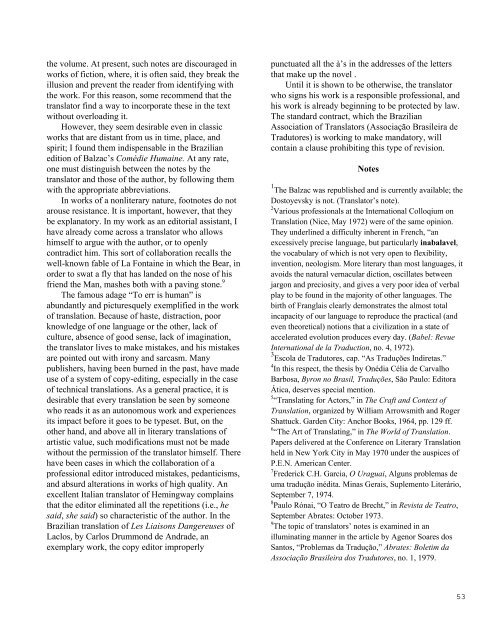their - The University of Texas at Dallas
their - The University of Texas at Dallas
their - The University of Texas at Dallas
Create successful ePaper yourself
Turn your PDF publications into a flip-book with our unique Google optimized e-Paper software.
the volume. At present, such notes are discouraged in<br />
works <strong>of</strong> fiction, where, it is <strong>of</strong>ten said, they break the<br />
illusion and prevent the reader from identifying with<br />
the work. For this reason, some recommend th<strong>at</strong> the<br />
transl<strong>at</strong>or find a way to incorpor<strong>at</strong>e these in the text<br />
without overloading it.<br />
However, they seem desirable even in classic<br />
works th<strong>at</strong> are distant from us in time, place, and<br />
spirit; I found them indispensable in the Brazilian<br />
edition <strong>of</strong> Balzac’s Comédie Humaine. At any r<strong>at</strong>e,<br />
one must distinguish between the notes by the<br />
transl<strong>at</strong>or and those <strong>of</strong> the author, by following them<br />
with the appropri<strong>at</strong>e abbrevi<strong>at</strong>ions.<br />
In works <strong>of</strong> a nonliterary n<strong>at</strong>ure, footnotes do not<br />
arouse resistance. It is important, however, th<strong>at</strong> they<br />
be explan<strong>at</strong>ory. In my work as an editorial assistant, I<br />
have already come across a transl<strong>at</strong>or who allows<br />
himself to argue with the author, or to openly<br />
contradict him. This sort <strong>of</strong> collabor<strong>at</strong>ion recalls the<br />
well-known fable <strong>of</strong> La Fontaine in which the Bear, in<br />
order to sw<strong>at</strong> a fly th<strong>at</strong> has landed on the nose <strong>of</strong> his<br />
friend the Man, mashes both with a paving stone. 9<br />
<strong>The</strong> famous adage “To err is human” is<br />
abundantly and picturesquely exemplified in the work<br />
<strong>of</strong> transl<strong>at</strong>ion. Because <strong>of</strong> haste, distraction, poor<br />
knowledge <strong>of</strong> one language or the other, lack <strong>of</strong><br />
culture, absence <strong>of</strong> good sense, lack <strong>of</strong> imagin<strong>at</strong>ion,<br />
the transl<strong>at</strong>or lives to make mistakes, and his mistakes<br />
are pointed out with irony and sarcasm. Many<br />
publishers, having been burned in the past, have made<br />
use <strong>of</strong> a system <strong>of</strong> copy-editing, especially in the case<br />
<strong>of</strong> technical transl<strong>at</strong>ions. As a general practice, it is<br />
desirable th<strong>at</strong> every transl<strong>at</strong>ion be seen by someone<br />
who reads it as an autonomous work and experiences<br />
its impact before it goes to be typeset. But, on the<br />
other hand, and above all in literary transl<strong>at</strong>ions <strong>of</strong><br />
artistic value, such modific<strong>at</strong>ions must not be made<br />
without the permission <strong>of</strong> the transl<strong>at</strong>or himself. <strong>The</strong>re<br />
have been cases in which the collabor<strong>at</strong>ion <strong>of</strong> a<br />
pr<strong>of</strong>essional editor introduced mistakes, pedanticisms,<br />
and absurd alter<strong>at</strong>ions in works <strong>of</strong> high quality. An<br />
excellent Italian transl<strong>at</strong>or <strong>of</strong> Hemingway complains<br />
th<strong>at</strong> the editor elimin<strong>at</strong>ed all the repetitions (i.e., he<br />
said, she said) so characteristic <strong>of</strong> the author. In the<br />
Brazilian transl<strong>at</strong>ion <strong>of</strong> Les Liaisons Dangereuses <strong>of</strong><br />
Laclos, by Carlos Drummond de Andrade, an<br />
exemplary work, the copy editor improperly<br />
punctu<strong>at</strong>ed all the à’s in the addresses <strong>of</strong> the letters<br />
th<strong>at</strong> make up the novel .<br />
Until it is shown to be otherwise, the transl<strong>at</strong>or<br />
who signs his work is a responsible pr<strong>of</strong>essional, and<br />
his work is already beginning to be protected by law.<br />
<strong>The</strong> standard contract, which the Brazilian<br />
Associ<strong>at</strong>ion <strong>of</strong> Transl<strong>at</strong>ors (Associação Brasileira de<br />
Tradutores) is working to make mand<strong>at</strong>ory, will<br />
contain a clause prohibiting this type <strong>of</strong> revision.<br />
Notes<br />
1 <strong>The</strong> Balzac was republished and is currently available; the<br />
Dostoyevsky is not. (Transl<strong>at</strong>or’s note).<br />
2 Various pr<strong>of</strong>essionals <strong>at</strong> the Intern<strong>at</strong>ional Colloqium on<br />
Transl<strong>at</strong>ion (Nice, May 1972) were <strong>of</strong> the same opinion.<br />
<strong>The</strong>y underlined a difficulty inherent in French, “an<br />
excessively precise language, but particularly inabalavel,<br />
the vocabulary <strong>of</strong> which is not very open to flexibility,<br />
invention, neologism. More literary than most languages, it<br />
avoids the n<strong>at</strong>ural vernacular diction, oscill<strong>at</strong>es between<br />
jargon and preciosity, and gives a very poor idea <strong>of</strong> verbal<br />
play to be found in the majority <strong>of</strong> other languages. <strong>The</strong><br />
birth <strong>of</strong> Franglais clearly demonstr<strong>at</strong>es the almost total<br />
incapacity <strong>of</strong> our language to reproduce the practical (and<br />
even theoretical) notions th<strong>at</strong> a civiliz<strong>at</strong>ion in a st<strong>at</strong>e <strong>of</strong><br />
acceler<strong>at</strong>ed evolution produces every day. (Babel: Revue<br />
Intern<strong>at</strong>ional de la Traduction, no. 4, 1972).<br />
3 Escola de Tradutores, cap. “As Traduções Indiretas.”<br />
4 In this respect, the thesis by Onédia Célia de Carvalho<br />
Barbosa, Byron no Brasil, Traduções, São Paulo: Editora<br />
Ática, deserves special mention.<br />
5 “Transl<strong>at</strong>ing for Actors,” in <strong>The</strong> Craft and Context <strong>of</strong><br />
Transl<strong>at</strong>ion, organized by William Arrowsmith and Roger<br />
Sh<strong>at</strong>tuck. Garden City: Anchor Books, 1964, pp. 129 ff.<br />
6 “<strong>The</strong> Art <strong>of</strong> Transl<strong>at</strong>ing,” in <strong>The</strong> World <strong>of</strong> Transl<strong>at</strong>ion.<br />
Papers delivered <strong>at</strong> the Conference on Literary Transl<strong>at</strong>ion<br />
held in New York City in May 1970 under the auspices <strong>of</strong><br />
P.E.N. American Center.<br />
7 Frederick C.H. Garcia, O Uraguai, Alguns problemas de<br />
uma tradução inédita. Minas Gerais, Suplemento Literário,<br />
September 7, 1974.<br />
8 Paulo Rónai, “O Te<strong>at</strong>ro de Brecht,” in Revista de Te<strong>at</strong>ro,<br />
September Abr<strong>at</strong>es: October 1973.<br />
9 <strong>The</strong> topic <strong>of</strong> transl<strong>at</strong>ors’ notes is examined in an<br />
illumin<strong>at</strong>ing manner in the article by Agenor Soares dos<br />
Santos, “Problemas da Tradução,” Abr<strong>at</strong>es: Boletim da<br />
Associação Brasileira dos Tradutores, no. 1, 1979.<br />
53

















